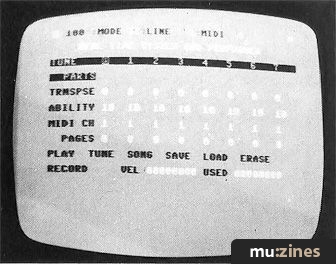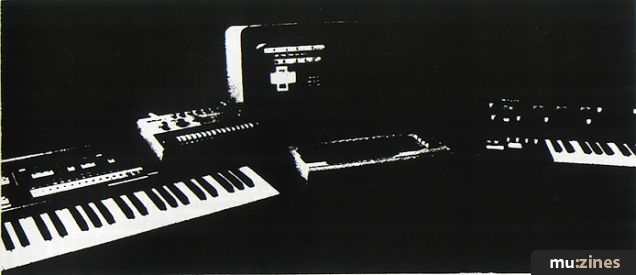Magazine Archive
Home -> Magazines -> Issues -> Articles in this issue -> View
All Systems Go! | |
Joreth.Article from Electronic Soundmaker & Computer Music, April 1985 | |
With Joreth's Hardware/Software MIDI control package for the CBM 64.
Tony Reed talks to Mick Jones of Joreth Software about their new MIDI controller for the CBM 64

Mick Jones at work... and play
After a bit of a shaky start, musical packages for home micros in general, and the Commodore 64 in particular, are starting to offer the kind of flexibility and power that musicians can really make use of — especially in the manipulation of MIDI equipment.
A new company, Joreth, have set out to challenge the landmark in CBM software set recently by RMS's 12 Channel Studio (See ES&CM Dec' 84-85) with their own — The Joreth Music Composer System, which, whilst offering 'only' 8 tracks of control (as opposed to RMS's 12) boasts a number of advantages over its rival...
Two-part harmony
We persuaded Mick Jones from the company to drop by our Sussex studio, to talk us through the system, and to use it in the creation of a piece for the tape.
So what precisely does the System consist of?
"Two parts — The AL 25 MIDI-Link interface which plugs into the user port of the '64; and the software itself, on disc. The interface (a black box about the size of a half-brick, and connected to the micro via a standard 25-way ribbon cable) has sockets for MIDI In, MIDI Out (x3) Sync In and Out (Roland-style 24ppqn Dins), a footswitch jack in for the 'live drop in' facility, a mixdown switch, line sync/run, and the dual-function 'Panic Button'. We've designed it to be as open-ended as possible, to deal with any future MIDI developments. Ditto, the software."
Before we get into the software itself, could you give an overview of its capabilities?
"Basically, it's an eight-track step or real-time recorder, with a capacity ranging from about 6000 notes in 'mixed mode' — (freely swapping from Real to Step and back again) to a maximum of about 8000 notes if you opt just for one mode exclusively... and that's only counting new musical events — repeats of song sections (Tunes) could stretch the notes played almost infinitely - using Sync, you could even link it to another Joreth, giving you a full 16-track mix - before you commit anything to tape."
Loading up

Fig 1 Realtime system and performer. Main Menu.
"First thing you see on loading is a title page, followed by a prompt, asking you to select Real or Step time. Selecting Real (R on the keyboard, funnily enough) gives you the main options page. (Fig.1) Nothing complicated here — along the top of the screen you have the various tempo, sync and resolution options, all toggled on or off via the appropriate lettered key — selected simply by moving the cursor onto the relevant part of the display using the normal CBM cursor controls.
"With the system initialised, move the reverse tile cursor to Record, Return, enter a Part (Track) number from 0 to 7 in response to the prompt, choose a sensible number in response to the 'Beats in Prompt', answer 'Y' to the 'New Tune?' prompt, and begin to play.
When you want to finish, press F7 — any trailing rests are deleted from memory, so no need to worry about glitches. Press shifted 'P' for playback. A * on the relevant column indicates that it has been recorded on. To overdub, select another (any order is possible), respond 'N' to the 'New Tune?' prompt, and repeat the procedures as before. This time, the track begins recording from the end of the count in, as opposed from the first note played — if you wanted to record a multitrack piece beginning with a pause, you'd first have to record a guide Part, and Erase it, or edit it from Step time. (Shifted 'S', 'Y' to the prompt. Return from Step time by pressing 'P'.)"
And how about memory availability?
"A row of spades across the top of the screen gradually make their way to a diamond on the far side, giving a rough indication of memory left — when you reach the diamond, you've automatically accessed single-format, giving you another 20-25% memory, at the expense of losing 'mixed mode'. When that's reached — though I've never done it — an on-screen error message tells you that you can't enter any more information."
How's the memory divided between track Parts?
"Any way you like — the machine plays to the end of the longest track, so you could have a short intro finish, and leave all the other tracks playing, no problem. Patch changes can be controlled from the program, and any combination of Parts, Real and Step Time, can then be built section by section into a complete Song consisting of a maximum of eight Tunes (sets of overdubbed Parts.) — and complete Songs can be dumped to disk."
"The footswitch lets you do live 'drop-ins', like a tape recorder, and the mixdown facility lets you merge tracks, to free others for more recording."
Like 'Overdub' on Roland's MSQ sequencers?
"Yes — although our method is a little more limited, since you don't retain independent MIDI information for the two tracks... pieces can be clocked from an on-board metronome, Roland Standard or MIDI-equipped drum machines, at a variety of base-time ratios; so if you're using Korg 48 ppqn equipment, or if you've recorded your melody as crotchets, but programmed the drum machine in minims — no problem! Just halve the ratio, using the Time Base function."
"Complementing that in Real Time on the 'on-board' side, you've got ten levels of 'Ability' (Joreth's odd word for Quantise), each of which is varied by a further three possibilities — the usual shifting of the whole note to the nearest musical event; the stretching of the front end of the note; or the compression of it onto the event; so you've got plenty of latitude to introduce 'feel' into a sequence. Every track can be quantised separately, so you could have a tight setting for backing tracks and a looser one for a more human melody line. Pitch bend and velocity sensing can be recorded if you want, but this uses up a lot of memory. To compensate, we've allowed you to record the information (which doesn't 'cost' much), but only use it in play back if you want to, on a particularly expressive passage for instance."
And the Panic Button?

Syntax Check Utility.
"That does two things; It interrupts playback of a complete step or a real-time piece, for editing — and it restores the program complete with current memory if something goes wrong, with a load from disk, for example."
Stepping out
Step time mode offered such a plethora of goodies that all space will allow is a brief overview. First thing to realise is that Step Time is actually a modified form of BASIC, called Composer, and employing an MCL syntax, i.e. entering a one-beat chord of C on the fourth octave would require you typing 'C4E4G4 .' (a modified character set on the keyboard allows all musical symbols — including dots and ties - to be entered). Fortunately, there are quicker methods of entry - pitch values can be entered direct from a MIDI keyboard, with its Tonebanks supplying the time symbols (!), or, fastest of all, up to two lines of time information may be entered, followed by pitch played from the MIDI synth. A buffer system prevents you out-playing the machine, and, since the time value stream can be made to cycle whilst new pitches are entered, this option is invaluable for rhythmically repetitive music. (12-bar, for instance.).

'Score' screen display.
Since the machine treats Step input as a program, editing is as per BASIC... a number of typical program utilities are included to make your life easier; Automatic line numbering, a Renumber facility which allows copying from one location to another. Append for writing long, linked compositions, and Create, which 'writes over' the step-time program into a real-time piece (which has to be done before it can be played back.) Score allows one or two part print-out to screen or printer of the Composer file in conventional musical notation - automatically!
The verdict
I was worried about the difficulty of reading and editing the mass of data even a short piece produced, but Joreth have thought of that, too — options are available for an 'expanded' screen display (just spacing, making everything more legible) or even a note by note breakdown of the whole thing!
Joreth have got themselves a winner, no question. I don't like their idiosyncratic terminology (Part for Track, Line for Sync, etc.) but the flexibility and openness of the system, together with the logic of their MCL impressed me greatly. The provisional manual I saw provided an entry point for everyone from the sit-down and play musician to the advanced programmer, yes, there are even facilities to access the Systems' elementary operational routines.) Whether you read music, play music or just listen to it, this System has the means to take you further.
Also featuring gear in this article
Publisher: Electronic Soundmaker & Computer Music - Cover Publications Ltd, Northern & Shell Ltd.
The current copyright owner/s of this content may differ from the originally published copyright notice.
More details on copyright ownership...
Review by Tony Reed
Help Support The Things You Love
mu:zines is the result of thousands of hours of effort, and will require many thousands more going forward to reach our goals of getting all this content online.
If you value this resource, you can support this project - it really helps!
Donations for April 2024
Issues donated this month: 0
New issues that have been donated or scanned for us this month.
Funds donated this month: £7.00
All donations and support are gratefully appreciated - thank you.
Magazines Needed - Can You Help?
Do you have any of these magazine issues?
If so, and you can donate, lend or scan them to help complete our archive, please get in touch via the Contribute page - thanks!









